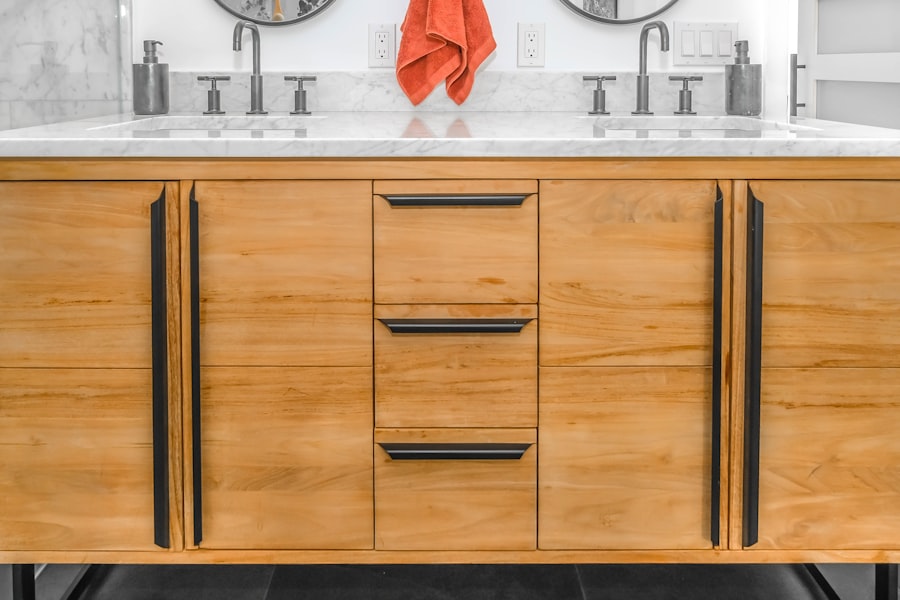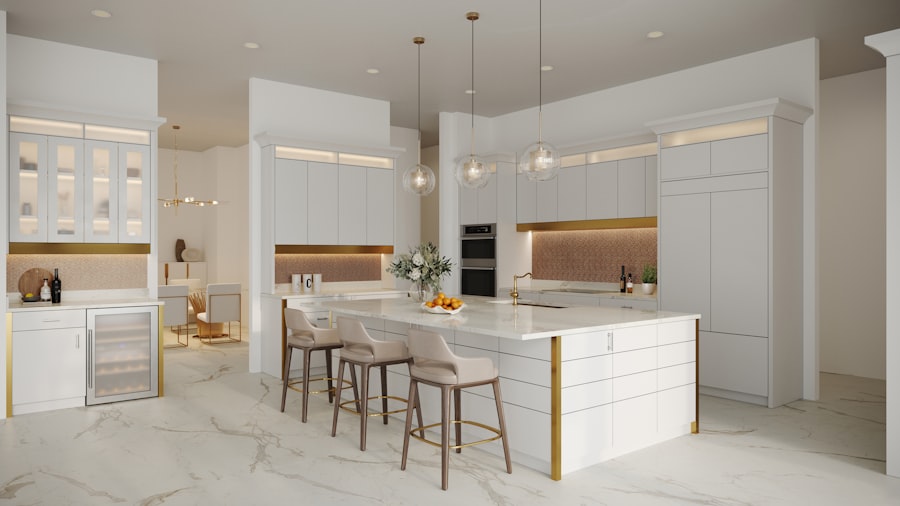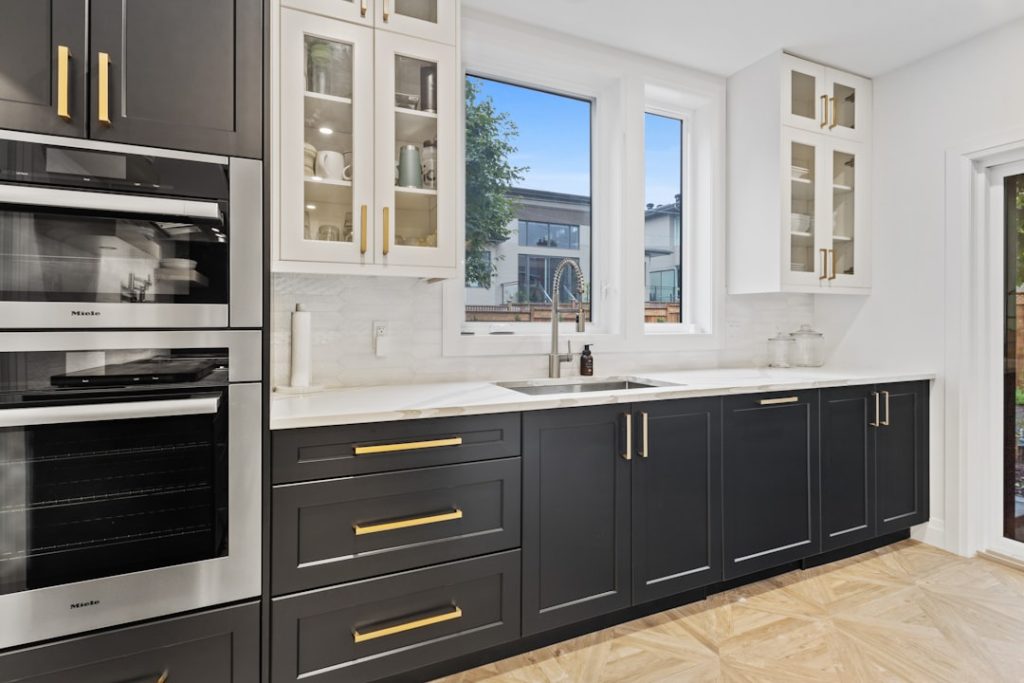Custom cabinets offer a multitude of advantages that can significantly enhance both the functionality and aesthetic appeal of a home. One of the primary benefits is the ability to tailor the cabinets to fit specific dimensions and layouts. Unlike pre-manufactured options, which often come in standard sizes, custom cabinets can be designed to utilize every inch of available space.
This is particularly beneficial in homes with unique architectural features or in smaller spaces where maximizing storage is essential. For instance, a kitchen with an irregular layout can benefit from custom cabinetry that fits snugly into corners or awkward nooks, ensuring that no space goes to waste. Moreover, custom cabinets allow homeowners to select materials, finishes, and styles that align with their personal preferences and the overall design theme of their home.
This level of personalization not only enhances the visual appeal but also contributes to the overall value of the property. High-quality materials and craftsmanship can elevate a home’s interior, making it more inviting and cohesive. For example, a homeowner who prefers a rustic aesthetic can choose reclaimed wood finishes, while someone with a modern taste might opt for sleek, high-gloss surfaces.
The ability to customize every aspect of the cabinets ensures that they not only serve a practical purpose but also reflect the homeowner’s unique style.
Key Takeaways
- Custom cabinets offer tailored storage solutions that enhance functionality and aesthetics.
- Selecting quality materials is crucial for durability and style in custom cabinetry.
- Designing cabinets to fit your specific space maximizes usability and visual appeal.
- Personalized customization allows cabinets to reflect your unique taste and home decor.
- Professional collaboration ensures your custom cabinet project meets your vision and adds home value.
Choosing the Right Materials for Your Custom Cabinets
Selecting the appropriate materials for custom cabinets is crucial, as it directly impacts both durability and appearance. Wood is one of the most popular choices due to its versatility and timeless appeal. Different types of wood, such as oak, maple, cherry, and walnut, each offer distinct characteristics in terms of grain patterns, color, and hardness.
For instance, oak is known for its strength and durability, making it an excellent choice for high-traffic areas like kitchens. On the other hand, cherry wood has a rich color that deepens over time, adding warmth and character to any space. In addition to solid wood, homeowners may also consider engineered materials such as plywood or MDF (medium-density fiberboard).
Plywood is often used for its stability and resistance to warping, while MDF provides a smooth surface ideal for painting. These materials can be particularly advantageous in environments with fluctuating humidity levels, as they are less likely to expand or contract compared to solid wood. Furthermore, the choice of finish—whether it be paint, stain, or veneer—can dramatically alter the final look of the cabinets.
A matte finish may lend a contemporary feel, while a glossy finish can create a more polished appearance.
Designing Your Custom Cabinets to Fit Your Space

The design process for custom cabinets should begin with a thorough assessment of the space they will occupy. This involves measuring dimensions accurately and considering factors such as ceiling height, existing architectural elements, and the overall flow of the room. For example, in a kitchen where ceiling height is significantly above standard levels, extending cabinets to the ceiling can create an illusion of grandeur while providing additional storage.
Conversely, in a smaller bathroom, opting for shorter cabinets can help maintain an open feel while still offering necessary functionality. Incorporating design elements that enhance usability is also essential. Features such as pull-out shelves, lazy Susans, and built-in dividers can make accessing items easier and more efficient.
Additionally, considering the placement of appliances and fixtures during the design phase ensures that the cabinets complement rather than obstruct these elements. For instance, if a homeowner has a double oven, designing cabinets that accommodate this appliance while providing adequate counter space can create a seamless cooking experience. Thoughtful design not only maximizes functionality but also contributes to an aesthetically pleasing environment.
Maximizing Storage and Organization with Custom Cabinets
| Metric | Description | Typical Value | Benefit |
|---|---|---|---|
| Storage Capacity Increase | Percentage increase in storage space compared to standard cabinets | 30-50% | Maximizes usable space, reduces clutter |
| Customization Options | Number of customizable features (shelves, drawers, dividers) | 5-10 options | Enhances organization tailored to needs |
| Material Durability | Average lifespan of cabinet materials | 10-20 years | Long-term investment and reliability |
| Space Utilization Efficiency | Percentage of cabinet volume effectively used | 85-95% | Reduces wasted space |
| Installation Time | Average time to install custom cabinets | 1-3 days | Minimizes disruption during setup |
| Cost Efficiency | Cost per cubic foot of storage space | Varies by design and materials | Optimizes budget for storage needs |
One of the standout features of custom cabinets is their ability to maximize storage and organization within a home. Traditional cabinetry often falls short in this regard due to fixed dimensions and limited options for internal organization. Custom cabinets can be designed with specific storage needs in mind, allowing homeowners to incorporate features that cater to their lifestyle.
For example, a family that enjoys cooking may benefit from deep drawers for pots and pans, while someone who entertains frequently might prioritize wine racks or glass-fronted display cabinets. In addition to accommodating various items, custom cabinets can also include innovative organizational solutions that enhance efficiency. Pull-out spice racks, built-in trash bins, and adjustable shelving are just a few examples of how custom cabinetry can streamline daily tasks.
Furthermore, incorporating vertical storage solutions can help utilize vertical space effectively; tall cabinets with pull-down shelves can make accessing items stored high up much easier. By focusing on organization during the design process, homeowners can create a system that not only looks good but also functions seamlessly in everyday life.
Customizing Your Cabinets to Reflect Your Personal Style
Custom cabinets provide an exceptional opportunity for homeowners to express their personal style through design choices. From selecting hardware to choosing colors and finishes, every detail can be tailored to create a cohesive look that resonates with individual tastes. For instance, someone who favors a minimalist aesthetic may opt for sleek lines and neutral colors, while another who loves vintage charm might choose ornate hardware and distressed finishes.
This level of customization allows homeowners to create spaces that feel uniquely theirs. Additionally, incorporating personal touches into cabinet design can further enhance their individuality. This could include adding glass doors to showcase cherished dishware or integrating decorative molding for an elegant touch.
Homeowners might also consider unique layouts or configurations that reflect their lifestyle; for example, creating an open shelving unit for displaying cookbooks or decorative items can add character while maintaining functionality. By thoughtfully customizing cabinets to reflect personal style, homeowners can transform their spaces into true reflections of themselves.
Working with a Professional to Bring Your Custom Cabinet Vision to Life

While some homeowners may feel confident in their ability to design custom cabinets independently, collaborating with a professional can significantly enhance the outcome. Experienced cabinet makers or designers bring valuable expertise to the table, ensuring that every aspect of the project is executed flawlessly. They can provide insights into current trends, recommend materials based on durability and aesthetics, and help navigate any potential challenges during the design process.
Moreover, professionals often have access to advanced tools and technology that can streamline production and installation. For instance, using computer-aided design (CAD) software allows designers to create detailed 3D renderings of the proposed cabinetry before any physical work begins. This not only helps homeowners visualize the final product but also allows for adjustments to be made early in the process.
By working with a professional, homeowners can ensure that their vision is realized with precision and quality craftsmanship.
Maintaining and Caring for Your Custom Cabinets
Proper maintenance is essential for preserving the beauty and functionality of custom cabinets over time. The type of material used will often dictate specific care requirements; for example, solid wood cabinets may need periodic polishing or conditioning to prevent drying or cracking. Regular cleaning with gentle soap and water is typically sufficient for most finishes; however, it’s crucial to avoid harsh chemicals that could damage the surface.
In addition to routine cleaning, homeowners should also be mindful of humidity levels within their homes. Excessive moisture can lead to warping or mold growth in wooden cabinets; therefore, using dehumidifiers in particularly humid areas like basements or bathrooms can help mitigate these risks. Furthermore, addressing any minor repairs promptly—such as tightening loose hinges or replacing worn-out hardware—can prevent more significant issues down the line.
By implementing these maintenance practices, homeowners can ensure their custom cabinets remain in excellent condition for years to come.
The Return on Investment of Custom Cabinets for Your Home
Investing in custom cabinets can yield significant returns when it comes time to sell a home or simply enjoy its enhanced functionality and aesthetics during ownership. Custom cabinetry often appeals to potential buyers due to its tailored fit and high-quality materials; this can lead to increased property value compared to homes with standard cabinetry options. According to various real estate studies, kitchens equipped with custom cabinetry tend to attract higher offers and sell faster than those without.
Beyond resale value, custom cabinets also contribute positively to daily living experiences within a home. The enhanced organization and personalized design can improve overall satisfaction with one’s living space, making it more enjoyable for both residents and guests alike. Homeowners who invest in custom cabinetry often find that it elevates their daily routines—whether cooking in a well-organized kitchen or enjoying a beautifully designed living area—ultimately making it a worthwhile investment in both quality of life and property value.



